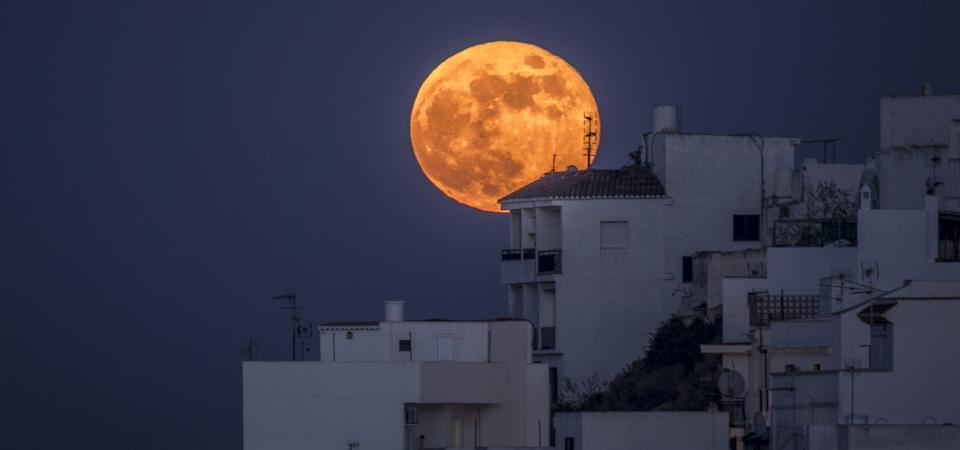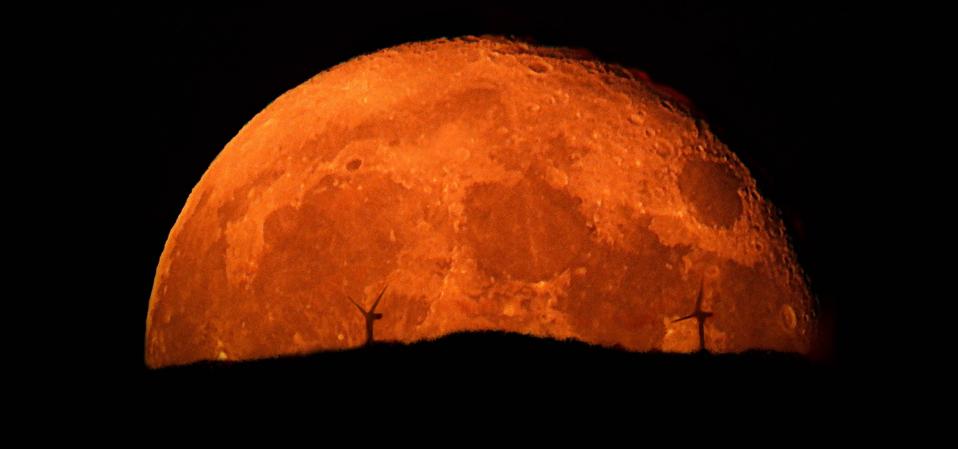
How, when and where you can see a spooky ‘Halloween Hunter’s Blue Blood Moon’ full moon this … [+]
getty
Are you ready for a full “Hunter’s Blue Blood Moon” this All Hallows’ Eve?
The Moon turns full every 29.5 days, but this year it syncs perfectly with Halloween and will thus look its best at dusk on the big day.
However, did you know it’s the second full Moon this month after October 1’s—the “Harvest Moon?”
With trick-or-treating canceled this year the chance to watch a fabulous full moonrise shouldn’t be passed up—and there are three chances to see a spectacular full Moon this weekend.
Its convoluted name may sound like a trick or treat in itself, but here’s everything you need to know about how, when and where to see the full Moon at its brilliant best this weekend:
Why is it called a ‘Hunter’s Moon’ and a ‘Blood Moon’?
The first name comes from the fact that ancient cultures used to prepare for winter during November by going hunting. Easy. The second term—“Blood Moon”—is for the same reason. So don’t confuse it with a total lunar eclipse—a rare phenomenon that’s popularly called a “Blood Moon.” The next lunar eclipse visible from North America is on May 26, 2021.
Saturday night’s full Moon will not look red, and nor will it look blue. So why the term “Blue Moon?”
Why is it called a ‘Blue Moon’?
Everyone knows that “once in a blue Moon” means a rare event. The “Halloween Hunter’s Blue Blood Moon” is the second full Moon in a calendar month that contains two full Moons. That’s a fairly rare event, though it actually happens once every two or three years. It’s actually only one definition of a “Blue Moon.”
It’s just a quirk of the calendar, and it’s definitely not a descriptive term—the full Moon will not look blue! Only very rarely does the Moon actually turn blue in our sky. That’s usually caused by volcanic eruptions or forest fires that send lots of smoke and fine dust into the atmosphere.
So if it’s not going to look red or blue, what’s the point of observing this month’s full Moon?
It’s because the “Halloween Hunter’s Blue Blood Moon” will look a delicate orange color, though only if you catch it at the right time.
As the full Moon—and this applies to all full Moons—rises above the eastern horizon on Saturday it will look spectacular. Rising as a muted orange orb, in a clear sky it will startle those not expecting it.
So here’s exactly when, where and how to see the “Halloween Hunter’s Blue Blood Moon” on All Hallows’s Eve—a full Moon that also ushers-in November’s “Frosty Moon Eclipse” (more on that below):

There are three specific times and places to look to see the “Halloween Hunter’s Blue Blood” full … [+]
getty
When is the ‘Halloween Hunter’s Blue Blood Moon?’
It will be officially 100% illuminated from our planet’s point of view on Saturday, October 31, 2020. The global moment of full Moon occurs at 14:49 Universal Time, so 14:49 BST in London, 10:49 a.m. EDT in New York City and 7:49 a.m. PDT in Los Angeles.
However, what most don’t realize is that the moment of maximum full-ness is not when to look at the full Moon.
The time to see our satellite at its best is at moonrise and moonset on the day of the full Moon, and sometimes the night before or after. All you need it great timing—and a cloud-free horizon.
The THREE times to see the ‘Halloween Hunter’s Blue Blood Moon’ at its best
The best time to see the “Halloween Hunter’s Blue Blood Moon” at its best will be at moonrise on the day that it’s full so check the times where you live. On full Moon day that happens very close to sunset. This year that’s Saturday, October 31—Halloween.
Here’s exactly when and where to look for three cities in Europe and North America (find out the exact times for the full moon’s rise and set for your location):
Where and when to see the ‘Halloween Hunter’s Blue Blood Moon’ rise at dusk on Friday, October 30, 2020
Look east as the Sun sets in the west. In practice you won’t see the full Moon appear until about 10-15 minutes after the moonrise time because of atmospheric cloud low on the horizon and other obstructions.
- London: Sunset is at 4:38 p.m GMT, moonrise is at 4:39 p.m GMT
- New York City: Moonrise is at 5:50 p.m EDT, sunset is at 5.55 p.m. EDT
- Los Angeles: Moonrise is at 5:56 p.m PDT, sunset is at 6:02 p.m. PDT
Where and when to see the ‘Halloween Hunter’s Blue Blood Moon’ set before just dawn on Saturday, October 31, 2020
Look west as the Sun rises in the east. In practice you’ll see the Harvest Moon disappear—after a gorgeous display of orangey hues—a few minutes before the official moonset time because of atmospheric cloud low on the horizon.
- London: Moonset is at 6:23 a.m GMT, sunrise is at 6:52 a.m. GMT
- New York City: Moonset is at 7:15 a.m EDT, sunrise is at 7:25 a.m. EDT
- Los Angeles: Moonset is at 7:10 a.m PDT, sunrise is at 7:12 a.m. PDT
Where and when to see the ‘Halloween Hunter’s Blue Blood Moon’ rise at dusk on Saturday, October 31, 2020
When and where can I see the full Moon rise on Halloween? That would be tonight on the eastern horizon:
- London: Sunset is at 4:36 p.m. GMT, moonrise is at 4:54 p.m.GMT
- New York City: Sunset is at 5.54 p.m EDT, moonrise is at 6:14 p.m. EDT
- Los Angeles: Sunset is at 6.01 p.m PDT, moonrise is at 6.24 p.m. PDT

Are you ready for a “Hunter’s Blue Blood” full Moon this Halloween?
getty
When is the next full Moon?
The next full Moon is a bit special. Called a “Frosty Moon Eclipse” or “Beaver Moon Eclipse,” it will occur on Monday, November 30, 2020 at 09:42 UTC. As well as being a full Moon it will also be a penumbral lunar eclipse. Visible only from North and South America, Australia and East Asia, about 83% of the Moon will slip into Earth’s outer shadow in space—its fuzzy penumbra—and consequently turn a dull grey color. That’s because most of the sunlight that illuminates it will be blocked by the Earth.
Wishing you clear skies and wide eyes.









